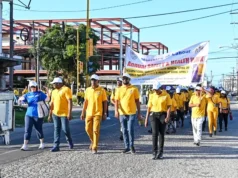By Joel Bhagwandin
In his column of December 15, 2023 Chartered Accountant, Lalbachan Chris Ram theorized that, “Guyana’s foregoing of profit oil necessarily adds to the windfall of the oil companies, allowing them the use of what is properly Guyana’s funds to finance petroleum activities.
“In other words, the government is putting up 50% of exploration investment—equal to the combined investment of Exxon, Hess, and CNOOC—in exploration, but has no seat at the table, and no say in decision making. And guess what? The Government cannot extract a single change in the concessions available to the oil companies.”
In a subsequent invited commentary by Kaieteur News (carried in their December 25th, 2023, edition), Ram reaffirmed his position that the Government is a de facto investor in the petroleum exploration activities with ExxonMobil, Hess, and CNOOC.
Ram also said there are two principal methods in raising financing, referring to shareholders’ equity and retained earnings, but that is incorrect. The two principal methods are in fact via debt financing instruments and equity financing instruments. Retained earnings, as Ram alluded to as one of the principal forms, is actually a form of equity financing, i.e., an internal source of financing). Along with making this critical distinction, this article seeks to demonstrate how the varying positions from the chartered accountant are fundamentally flawed. Moreover, this article seeks to provide readers with an alternative perspective grounded in an empirical discussion and analysis in relation to the aforesaid issues.
The notion that the Government is putting up 50% of the exploration investment but has no seat at the table and no say in decision making is an egregiously distorted and false narrative. Proponents of this view are premising their belief on the supposed “foregone” revenue attributed to the lack of ring-fencing, 50% of which should have been profits for the Government at the outset.
Ram contended that this supposed “foregone” revenue is equivalent to “retained earnings” or equity. This concept, however, is a matter of creative interpretation albeit flawed; as opposed to an analysis grounded in facts considering the policies and decisions of the Government; the framework of the Petroleum Agreement (2016); and the tradeoffs among other factors.
In strict terms, the terminology “foregone” means to “give up”. But the Government is not necessarily “giving up” revenue owing to the lack of ring-fencing. Rather, owing to the lack of ring-fencing, as I argued in previous articles, the Government made a deliberate decision to ramp up production rapidly. Consequently, what proponents refer to as “foregone” revenue, is in fact a “tradeoff”.
The tradeoff is simply trading “short-term” gains for maximized gains achievable in the medium-term. In that regard, I demonstrated in several articles (recently) that all things being equal, the exploration/prospecting licence pursuant to the Petroleum Agreement (2016) expires in 2027. Thus, with ExxonMobil Guyana aiming to bring online 10 Floating Production Storage and Offloading (FPSOs) vessels by 2030, which will enable increased production to upwards of 1.3 million barrels per day, coupled with a short payback period of three to five years attributable to the 75% cost-recovery ceiling, the total exploration and development costs may be fully recovered by 2035.
This means that, all other things being equal, the Government’s take by 2030 could reach an estimated US$4.7 billion annually (larger than the pre-oil GDP), and peak at around US$8 billion annually by 2035 and thereafter (all other things being equal). By then, the Government’s take will increase from 14.5% (during the recovery period) to between 25%-30% (post-recovery period by the year 2035) from the Stabroek Block, under the 2016 Petroleum Agreement.
It is worth noting that the size of the Stabroek Block is an estimated 26,806 km2, and to date, based on the size of the project development area (PDA) for all the discoveries (46 discoveries), less than 2% of the Stabroek Block has been explored (after 24 years of exploration activities). Therefore, by 2027, when the 2016 Petroleum Prospecting Licence expires, not more than 3%-5% of the Stabroek Block will have been explored, thereby effectively placing the Government in a position to re-possess at least 95% of the Stabroek Block, following which the new fiscal terms, inter alia, the new model Petroleum Agreement (s) shall be applied to any new exploration and production licences.
Moreover, the tradeoff on account of the lack of ring-fencing that Ram refers to as “foregone” revenue, which he mischaracterized as equity―to lend credence to his notion that the Government is a de facto investor, is another false premise. The fact is that it is not only the classification of the “tradeoff” or “foregone” revenue that one has to consider, one has to also consider the source of funding and “who” raised the funding.
In this case, within the framework of the Petroleum Agreement (2016) and the Petroleum legislation, it is the oil companies’ that raised the initial capital in the form of both equity and debt financing, not the Government. With that in mind, legally and technically, the Government is neither a de facto investor nor a direct investor in the Stabroek Block.












